|
||||||||
Texas Instruments ? Texas who ?The company is
born May 16, 1930 in the wildcat oil days in Texas. John Clarence
"Doc" Karcher and Eugene McDermott start Geophysical Service,
using seismology to find oil. The company begins with 12 exploration crews
living a nomadic life in the oilpatch. In the '40s, new owners and a new
direction shape the future. The day before Pearl Harbor, Eugene McDermott,
Cecil Green, Erik Jonsson and H.B. Peacock buy Geophysical Service Inc.
(GSI). |
||||||||
Transistors and Radios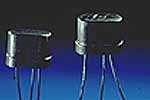 On
May 10, 1954 Texas Instruments announced a revolutionary new electronic
product, the silicon transistor. Searching for a killer application, TI
developed the first commercial available miniaturized transistor radio
marketed as the Regency TR1. Read the press release, dated October 18,
1954. On
May 10, 1954 Texas Instruments announced a revolutionary new electronic
product, the silicon transistor. Searching for a killer application, TI
developed the first commercial available miniaturized transistor radio
marketed as the Regency TR1. Read the press release, dated October 18,
1954. |
||||||||
| TI Supplying Transistors for First
"Pocket Size" Radio TI's part in the production of the first
commercial transistorized radio receiver will be announced beginning today
in newspapers throughout the country.
The "pocket size" radio has four TI transistors. It also uses a TI subminiature output transformer. The transistors - technically known as n-p-n grown junction germanium triodes - are made in the Semiconductor Products Division. The transformer is a product of the Components Division. Their application to the new radio receiver accounts for a large part of the increased production and employment in the two divisions in recent weeks. The Apparatus Division has also had a hand in the tiny radio, having worked on engineering problems and the machining and fabricating of models for the plastic case. The receiver is being assembled and marketed by the Regency Division of Industrial Development Engineering Associates, Inc., Indianapolis. It will be available this week to the public through sales outlets in Los Angeles and New York City. When production permits, it will be sold in cities throughout the country. For competitive reasons it was decided to keep the development of the radio, including TI's part in it, "under wraps" until the unit was ready for marketing. The radio receiver measures 5 x 3 x 1 1/4 inches - the smallest set commercially available - with the semiconductor devices themselves occupying less than 1/10 of a cubic inch. The "pocket size" is a significant achievement since it includes a high fidelity, high volume speaker and a single battery supply as well as all associated receiver circuit components. Gain at radio frequency with the germanium transistor is sufficient to permit a combined mixer-oscillator stage. Only two intermediate frequency stages are required and, following a germanium diode detector, one audio amplifier stage. Audio volume fidelity and reception range are the equal of or superior to that of the small vacuum tube-equipped portable radios. The introduction of this first mass production item to use the tiny transistor to replace the fragile vacuum tube leads the way for the long-predicted transistorization and miniaturization of many other mass production consumer devices. TIers can justly be proud of being the first to produce a high-gain transistor at a cost permitting its application to the high-volume commercial market. |
||||||||
Texas Instruments Invented the Integrated CircuitIt was a relatively simple device that Jack Kilby showed to a handful of co-workers gathered in TI's semiconductor lab almost 40 years ago -- only a transistor and other components on a slice of germanium. Little did this group of onlookers know, but Kilby's invention, 7/16-by-1/16-inches in size and called an integrated circuit, was about to revolutionize the electronics industry. The Answer to a ProblemIt was in a
deserted laboratory at TI's brand new Semiconductor Building where Jack
Kilby first hit on the idea of the integrated circuit. In July 1958, when
everyone else left for the traditional two-week vacation period, Kilby
stayed to man the shop. Enter KilbyTI was working
on the Micro-Module program when Kilby joined the company in 1958. Because
of his work with Centralab in Milwaukee, Kilby was familiar with the
"tyranny of numbers" problem facing the industry. But he didn't
think the Micro-Module was the answer — it didn't address the basic
problem of large quantities of components in elaborate circuits. Early SuccessesKilby had made
a big breakthrough. But while the U.S. Air Force showed some interest in
TI's integrated circuit, industry reacted skeptically. Indeed the IC and
its relative merits "provided much of the entertainment at major
technical meetings over the next few years," Kilby wrote. The Cal-Tech ProjectThe program
that resulted in the development of the hand-held calculator grew out of a
September 1965 conversation between Jack S. Kilby, then a lab director at
the Dallas headquarters of Texas Instruments, and two of his colleagues, Jerry
D. Merryman and James
H. Van Tassel. Kilby had invented the integrated circuit (IC) at TI in
1958, and he and the company share a natural interest in demonstrating how
the devices could be used and in broadening the market for them. Texas Instruments approached Canon Inc. (Tokyo) and arranged to coproduce a pocket calculator completely built with Texas Instruments parts. In April 1970, the Pocketronic appeared on the Japanese market; it was a four-function, entirely electronic calculator that retailed for about $400. The machine was marketed in the United States in the fall of that year. The Pocketronic was in one line with other battery operated calculators like the Busicom LE-120, Sanyo ICC-0081 and Sharp EL-8. (Read more about Sharp company here.) The inventors
filed a U.S. patent application later in 1967, and the U.S. Patent Office
issued patent number 3,819,921 on June 25, 1974. On December 4, 1975, the Smithsonian
Institution accepted TI's donation of the prototype device for its
permanent collection. |
||||||||
The "Calculator-on-a-chip"The "calculator-on-a-chip" was an MOS integrated circuit announced by TI in September 17, 1971. Read the original press release here: This single chip may make
full electronic calculators available to everyone at prices that can put a
calculator into every kitchen or businessman's pocket. The chip
incorporates all of the logic and memory circuits to perform complete
8-digit 3-register calculator functions, including full precision add,
subtract, multiply, and divide operations. |
||||||||
|
||||||||
|
The TMS1802 has been designed to operate with
very few external components. A simple switch matrix keyboard can be used,
because encoding and debouncing are performed on the chip. This calculator
chip has been designed to be used with most popular segmented displays.
The display outputs are fully decoded, including inter-digit blanking and
leading-zero suppression. Only simple buffers are needed to drive most
numerical displays currently available. The TMS1802 has also been designed
to operate with simple seven- or eight-segment visible light-emitting
diodes or liquid-crystal optoelectronic displays. The basic calculator logic unit consists of a 3520-bit read-only program memory; a 182-bit random-access memory; and a decimal arithmetic logic unit as well as control, timing, and output decoders. The calculator circuit is implemented on a single 230 by 230 mil chip of silicon which is mass produced using the standard silicon nitride MOS process. Functional variations of the standard calculator chip are easily made, because the entire circuit has been designed using TI programmable logic array (PLA) techniques. Functional variations of the basic circuit can be made by changing a single photomask in the manufacturing process. Architecture of the calculator chip is such that the basic chip can host most calculator computing functions requiring up to 8-digit characteristics. The device is totally programmable, the "program" read-only memory, timing sections, control section and input/output decoders can be programmed to achieve different computing characteristics. This approach offers maximum design flexibility at very low cost. It is important to understand that the TMS1802 is a specific implementation of a basic or host calculator logic chip. Any number of special operational characteristics can be easily implemented by TI using single-level mask programming techniques of the same basic or host design. The only limitations are the size of the program ROM, the RAM storage, and the control, timing, and output decoders. For example, by reprogramming the output decoders the TMS1802 can be used to drive decimal displays such as Nixie type tubes. It is also expected that the ease of program variations will make the basic calculator logic chip suitable for many other non-calculator applications such as meters, registers, terminals, controls, and logic elements. Typical meter applications may include clocks, scales, utility, speed event, and digital volt meters. In a 28-pin plastic dual-in-line package, the 8-digit TMS1802NC calculator circuit is priced as follows F.O.B. U.S.A:
The unit is immediately available in distribution quantities. Production quantities are available in six weeks after receipt of order. Texas Instruments Incorporates. Dallas, Texas The chip provided the equivalent of some 5000 transistors. Changing a single photo mask permitted functional variations, including slide rule type calculations as well. Patent No. 4074351 was issued in July, 1971, to Gary Boon and Michael J. Cochran and assigned to TI. The TMS1802 was later renamed to TMS0102, the basic chip design was known as the TMS0100. Variations were made to fit individual calculator requirements for outside customers as well as Texas Instruments. About 25 years later the US Patent Office officially recognize Gary Boone and TI as the inventor of the single-chip microcontroller. More about the TMS0100 could be found here. |
||||||||
The Minimath ProjectThe Minimath was the first calculator designed by Texas Instruments for production. After evaluation of a limited production quantity, it was decided not to place it in production. The Minimath uses the TMS0111 variation of the TMS0100 design. The Datamath ProjectThe Design of the Datamath
The development of both the TI-2500 and the desktop models TI-3000/TI-3500 was done parallel. The design, the internal construction and other details are similar. Remarkable that even the nicknames of the calculators kept similar until the final introduction of the products. The picture on the right is titled "ADVANCED INFORMATION" and announced the Deskmath calculator LP3500. Even on the key plate you'll find the name Deskmath printed to give the association to the Datamath, the portable sibling with the official model designation TI-2500. Well, history told us that the calculator was introduced as a TI-3000 with a restyled keyboard and without the nice key plate. Some decades after the introduction we will smile reading the topics of this announcement: Easy to
operate. Press the
keys exactly as you say the problem. Adds. Subtracts. Multiplies. Divides. Texas
Instruments Incorporates. Dallas, Texas The Introduction of the DatamathThe official introduction of the TI-2500 Datamath portable calculator and the desktop models TI-3000 and TI-3500 dates back to September 21, 1972. Please find a reprint of the text published by Texas Instruments, Dallas, TX and additional picture provided by Fred M. Gore, Carrollton, TX. |
||||||||
| Texas
Instruments Enters Calculator Market With Three New Electronic Calculators
A line of
three new calculators introduced today marks the formal entry of Texas
Instruments into the electronic calculator market. The three new
calculators are the TI-2500 portable calculator and the TI-3000 and
TI-3500 desk models. Special ThanksSpecial thanks to the designer of the wonderful Datamath calculator, Fred M. Gore of Fred Gore & Associates, Inc. consulting industrial designers of Carrollton, Texas. Member of the Industrial Designers Society of America. Datamath™ is a trademark of Texas Instruments. |
||||||||
|
This
article was originally posted in http://www.datamath.org
and it has been reproduced with the permissions of his author.
James Redin - March, 2002 |
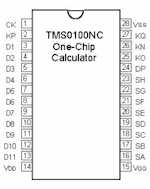
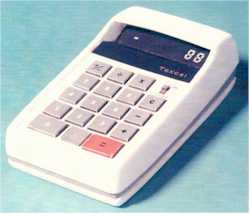 Think
about the "soap-box" design of the first US-built calculator
Think
about the "soap-box" design of the first US-built calculator 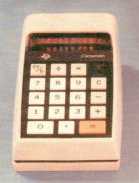 The
TI-2500 electronic calculator performs addition, subtraction,
multiplication, and division. For a credit balance, a minus sign appears
on the display to indicate the true value of the negative results. The
unit utilizes full-floating-decimal-point operation. The TI-2500 can
perform both chain and mixed calculations or utilize a stored constant for
either multiplication or division. Solid-state components, integrated
circuits, and a display using light-emitting diodes provide dependable
operation and long life. Extensively test-marketed under the
"Datamath" designation, the TI-2500 was well received by both
end users and retailers. One retailer has been quoted as having had a
defective rate of only one percent with the TI-2500 as compared to a store
average of ten percent.
The
TI-2500 electronic calculator performs addition, subtraction,
multiplication, and division. For a credit balance, a minus sign appears
on the display to indicate the true value of the negative results. The
unit utilizes full-floating-decimal-point operation. The TI-2500 can
perform both chain and mixed calculations or utilize a stored constant for
either multiplication or division. Solid-state components, integrated
circuits, and a display using light-emitting diodes provide dependable
operation and long life. Extensively test-marketed under the
"Datamath" designation, the TI-2500 was well received by both
end users and retailers. One retailer has been quoted as having had a
defective rate of only one percent with the TI-2500 as compared to a store
average of ten percent. 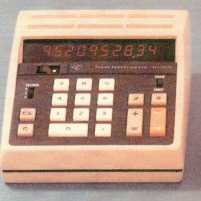 Designed
for both home and office use, the new Texas Instruments TI-3000 desk
electronic calculator has a suggested retail price of under $85. An
attractive desk calculator, the TI-3000 is light enough (less than 30
ounces) to conveniently carry in a small briefcase. The calculator
operates directly from standard house current through a nondetachable
plug-in cord.
Designed
for both home and office use, the new Texas Instruments TI-3000 desk
electronic calculator has a suggested retail price of under $85. An
attractive desk calculator, the TI-3000 is light enough (less than 30
ounces) to conveniently carry in a small briefcase. The calculator
operates directly from standard house current through a nondetachable
plug-in cord. 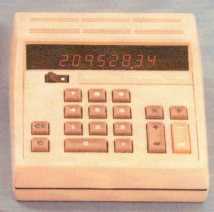 With
a suggested retail price of under $100, the TI-3500 desk electronic
calculator is a step-up model designed primarily for business or home
office use. In addition to the features of the TI-3000, the TI-3500 has
the chain/constant feature (also offered on the TI-2500) as well as a
choice of a completely floating decimal point or presetting the decimal at
either the second or fourth decimal position. Also, the TI-3500 has a
ten-digit gas-discharge display instead of the eight-digit one for the
TI-3000.
With
a suggested retail price of under $100, the TI-3500 desk electronic
calculator is a step-up model designed primarily for business or home
office use. In addition to the features of the TI-3000, the TI-3500 has
the chain/constant feature (also offered on the TI-2500) as well as a
choice of a completely floating decimal point or presetting the decimal at
either the second or fourth decimal position. Also, the TI-3500 has a
ten-digit gas-discharge display instead of the eight-digit one for the
TI-3000.